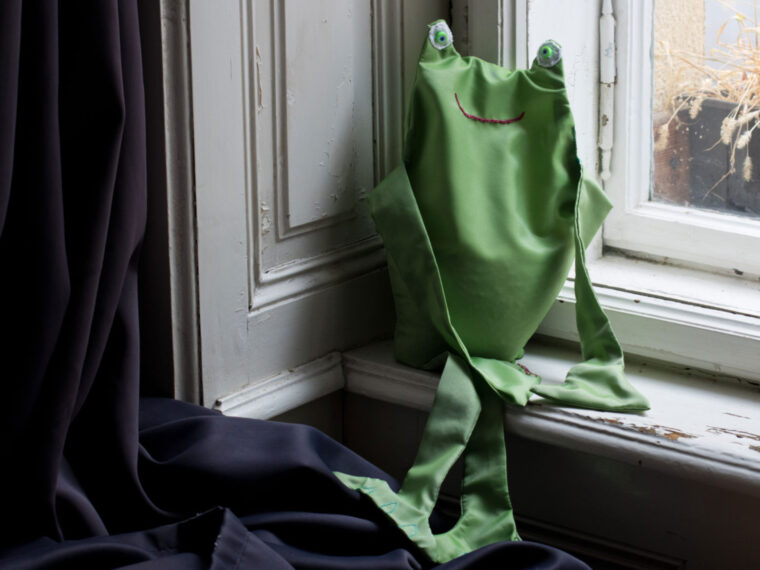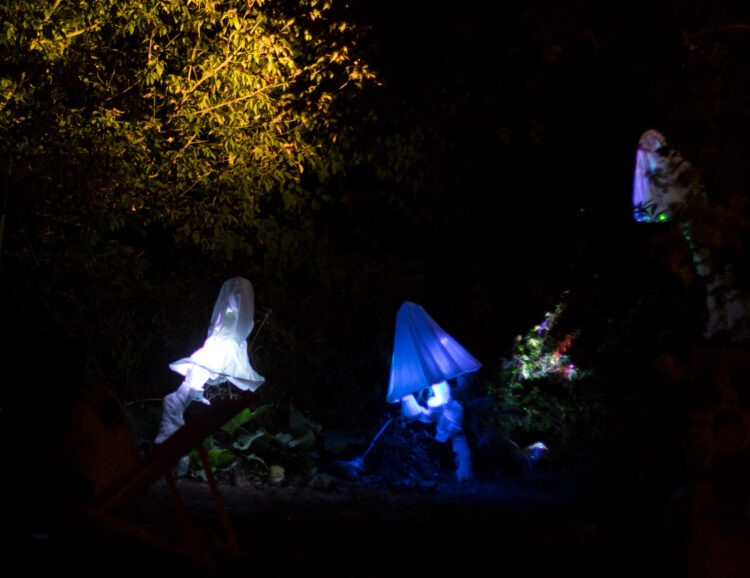
…mit einigem Gebackenem, dreimal Streetfood (Thai bei AllReis, Italienisch bei Turbopizza, Türkisch bei Damla), drei Filmen (Love, Simon, Challengers, Priscilla), viel Häkeln, ein bisschen Stricken, meiner ersten englischsprachigen byline in der Seattle Times – und wie immer, den besten Links der letzten Wochen.
Seit dem letzten Zuckersüß habe ich Schwarzer Sesam Cookies (Rezept von 2022) mit Cranberries, Mini-Zwetschgen-Pies (Rezept von 2021 minus Ingwer), Hollerbeeren-Pancakes und Quasi-Poptarts für den Geburtstag einer Freundin gebacken. Letztere bestanden aus Pie-Teig, gefüllt mit Griacherl-Holler-Marmelade, und waren mit einem Guss aus Puderzucker, Holunderbeerensirup, Zitronensäure und ein paar Tropfen Sahne bestrichen. Konzeptuell fand ich sie super, in der Umsetzung haperte es: der Teig war mir ein bisschen zu fettig, außerdem ist die Füllung an allen Ecken und Enden herausgeronnen.
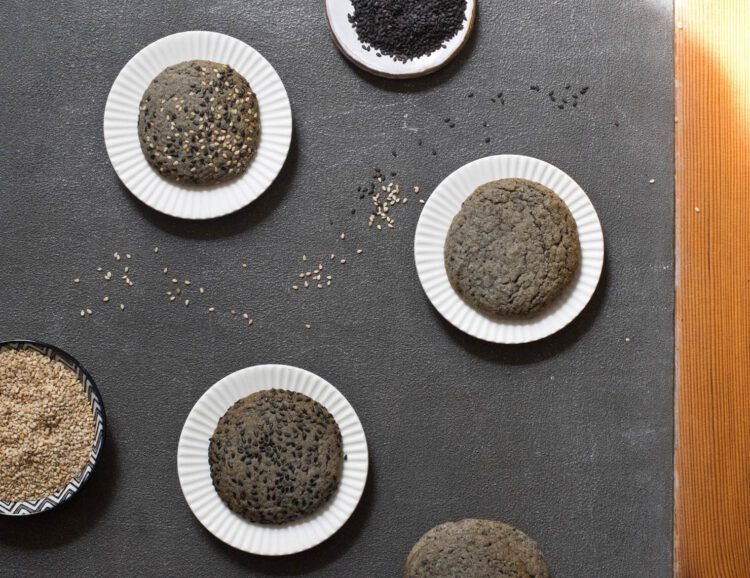


Gegessen

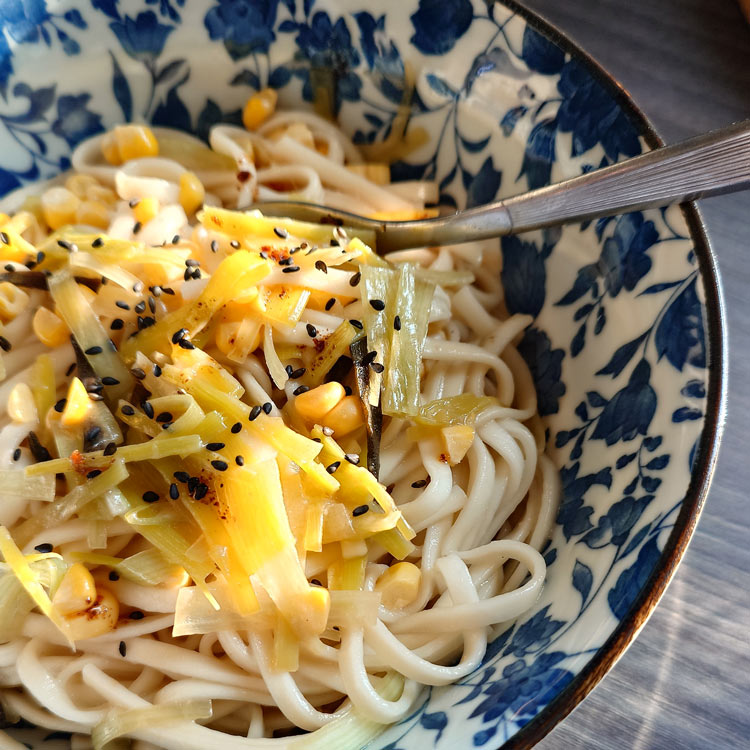
Kartoffel-Sellerie-Gratin mit Kapern in brauner Butter und Zitrone (grob nach Ottolenghi/NYT). Corn Chowder mit Jalapenos aus dem Glas und bissl Kümmel (inspiriert von der super Suppe im Café Caché Anfang Juli), obendrauf Cheddar. Dazu mit Cheddar überbackene Tortilla-Chips und Guacamole mit Tomaten aus dem Garten. Involtini di zucchine (nach lamiacucina), dazu gebackene Kartoffelspalten und griechisches Joghurt. Ramen-Nudeln mit Miso-Butter, Lauch, Braunalgen, schwarzem Sesam, Zuckermais und Chili-Öl.
Dreimal Streetfood: Turbopizza, AllReis, Damla
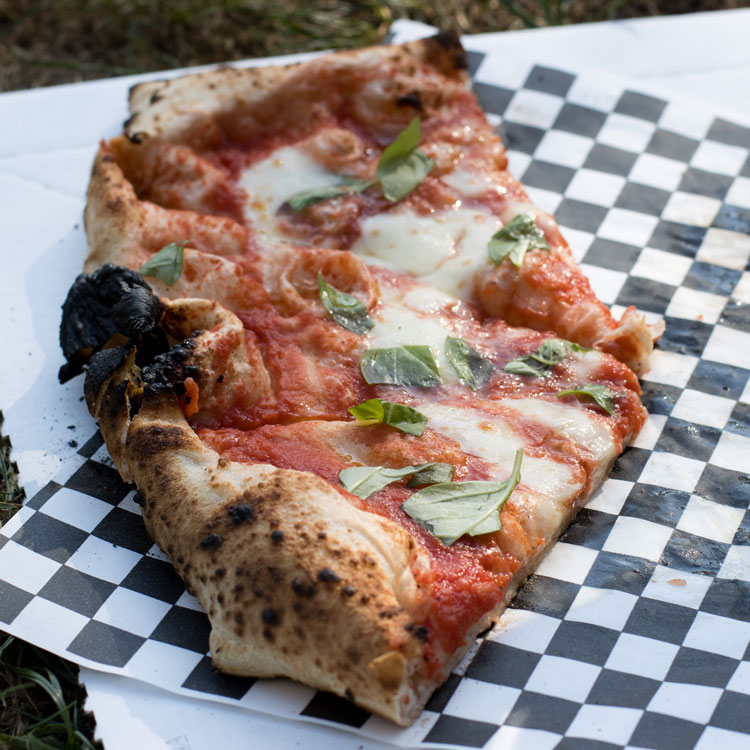
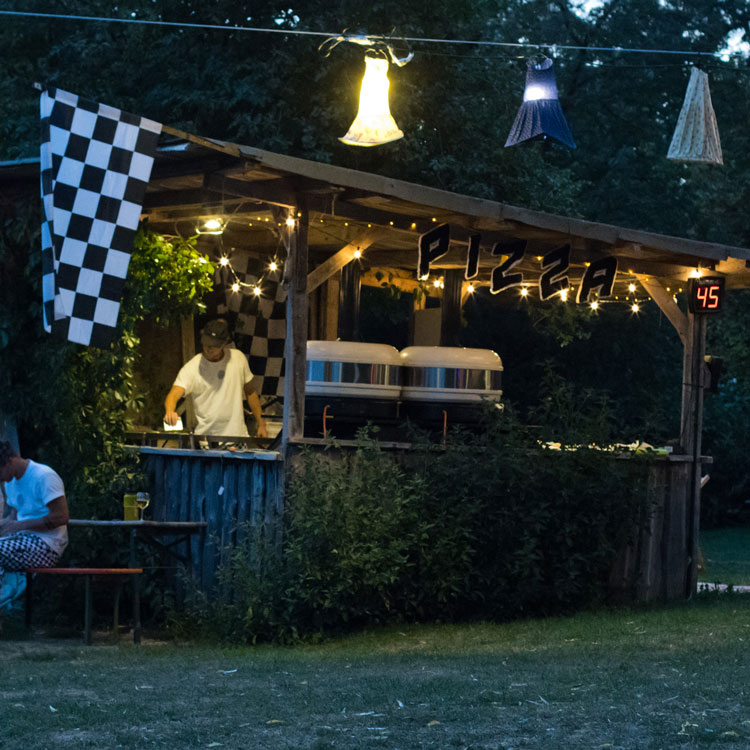
Eine ziemlich gute Margherita von @turbopizza.vienna, die vergangenes Wochenende auf einem Mini-Festival als Pop-Up vertreten waren, inklusive getuftetem (!) „Teppich“-Logo, schwarz-weißem Zielfahnen-Branding und italo-inspiriertem 80s-Soundtrack. Sie wollen ~bald~ in Favoriten ein Restaurant aufsperren, ich bin gespannt.
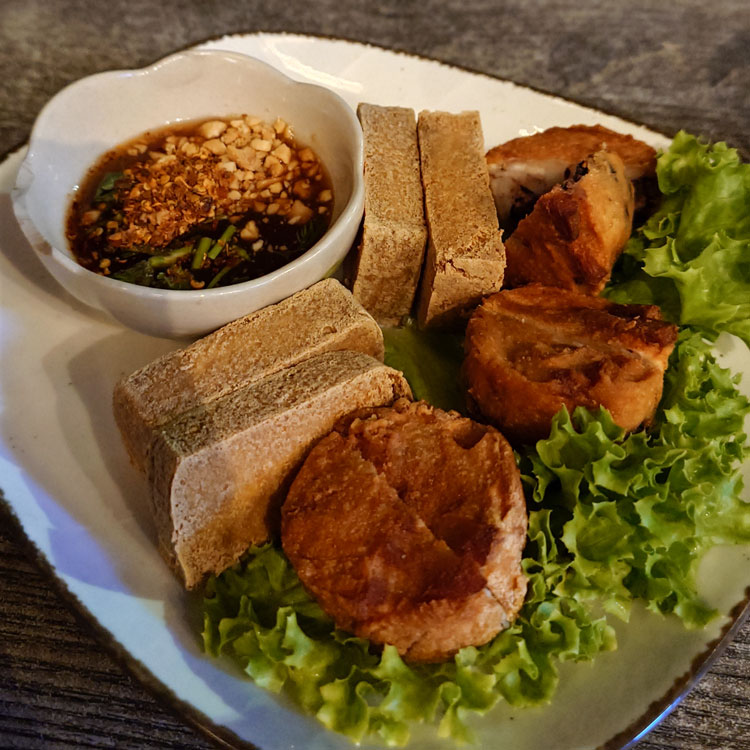
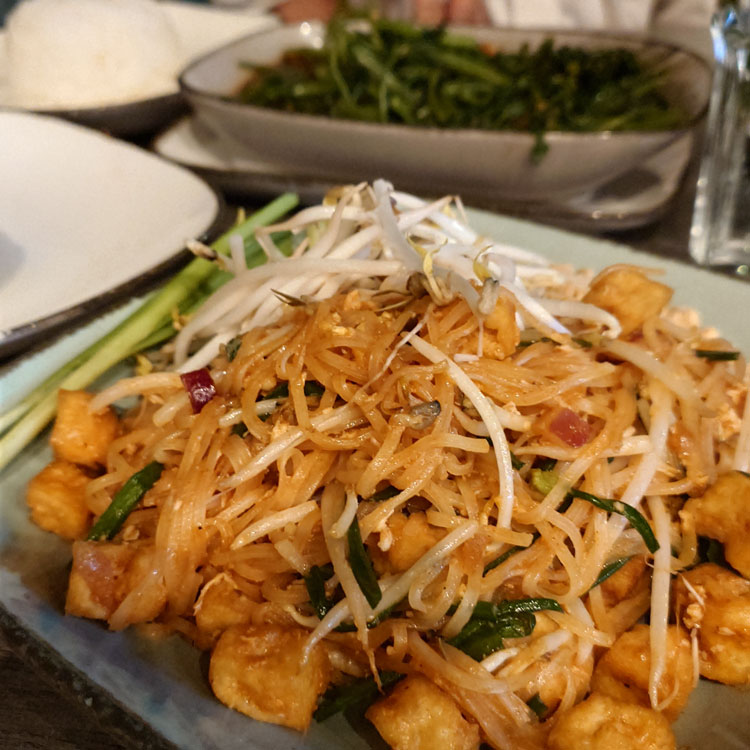
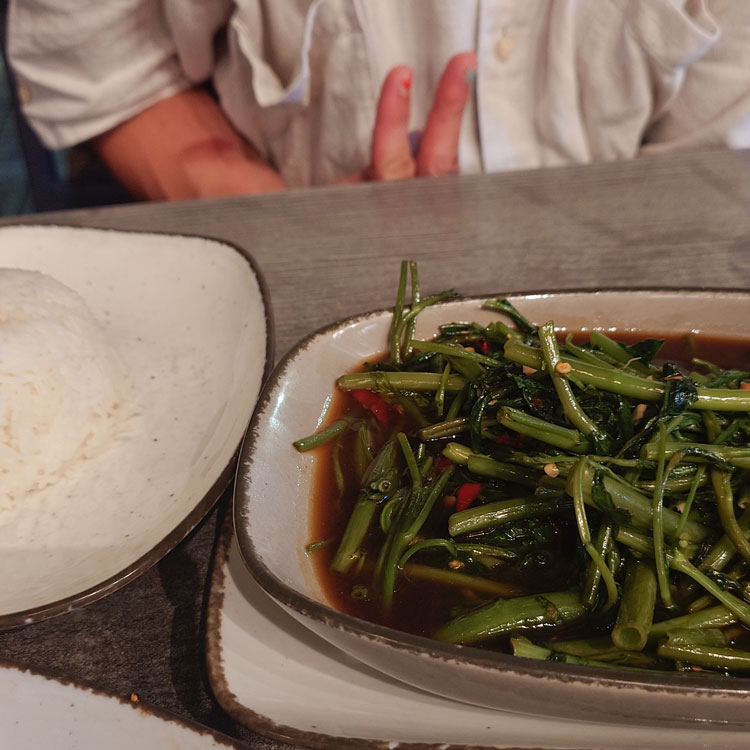
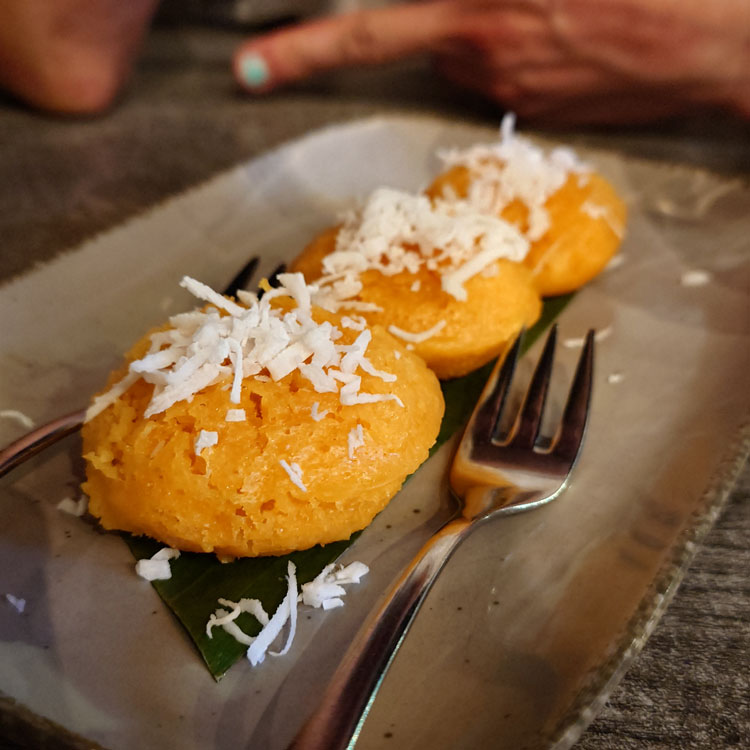
Vier Teller im AllReis Bangkok Streetfood (1150): Teua Ka Ko (6,90€), frittierter Tofu und Küchlein aus Klebreismehl mit schwarzen Bohnen mit sirupig-süß-sauer-scharfer Sauce, Erdnüssen und Koriander. Pad Thai mit Tofu (12,90€). Pad Pak Boon Fai Daeng (12,90€), gebratener Wasserspinat in scharfer, malziger, knoblauchiger Sauce mit Reis. Kanom Tarn (5,50€), fluffige, hefige, süße gedämpfte Küchlein (aus Reismehl?) mit saftigen salzigen Kokosraspeln obenauf – mochte ich sehr.
Acma mit Spinat und Schafskäse (2,20€), Pistazien- und Walnuss-Baklava (2,20€) spätabends bei Damla (1120).
Gesehen
Love, Simon (schnulzig), Challengers (nervig??), Priscilla (schockierend/verstörend) im Delta Airlines inflight entertainment. Von Priscilla habe ich in der ersten Filmhälfte, wo sie noch zur Schule geht, einige sehr grisselige „screenshots“ gemacht, denn die Strickmode darin ist toll (fusseliger pinker Kurzarm-Pulli mit kleinem Kragen, blauer Langarm-Pulli mit v-förmigen weißen Streifen um den Kragen, diverse Cardigans). S.a.: ‘She Says Good-bye to Him in Pants’ – Vulture über das Kostümdesign im Film.
Gestrickt/gehäkelt
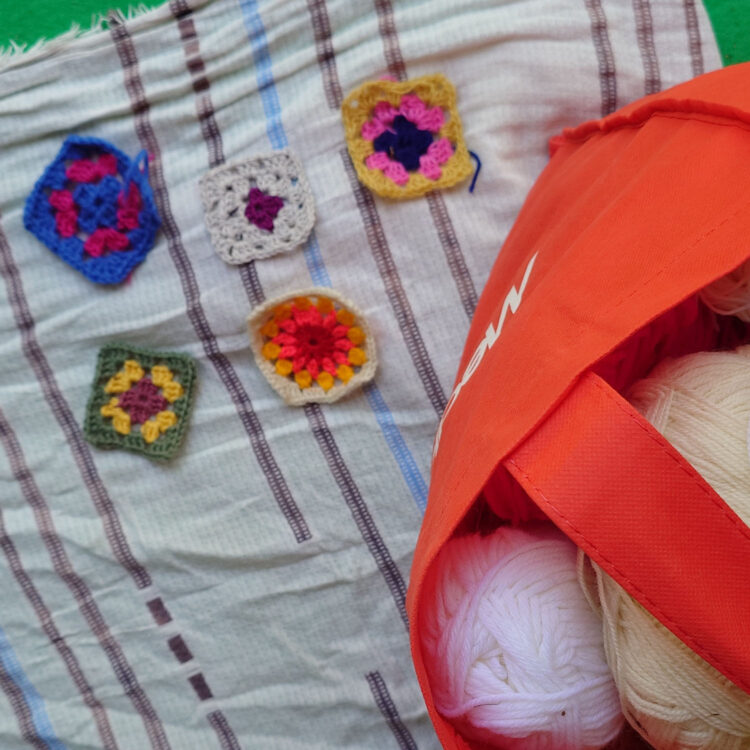
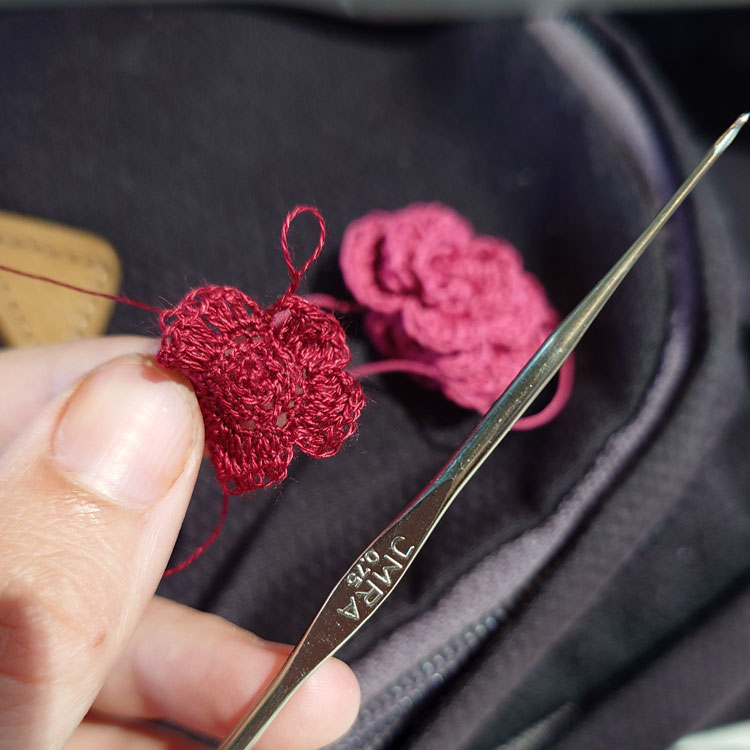

Einige Granny-Squares, als Workshop-Leiterin für Häkelanfänger_innen auf dem bereits erwähnten Festival. Eine kleine Rose aus 10er Häkelgarn und dann eine zweite, noch winzigere Version aus einem einzelnen Stickgarn-Faden. Mit der 0,75mm Häkelnadel hatte ich dauernd das dringende Bedürfnis nach einer Lupe. Ich glaube, wenn man die fertige Rose ohne eine solche anschaut, fallen die Fehler, die ich aufgrund schlechter Sicht gemacht habe, so immerhin nicht auf.


Ich habe außerdem mein drittes SassyClassyCropTop (pattern von Ann-Kathrin Stoll bei ravelry) angeschlagen, aus Hempathy, einem beigen Baumwoll-Hanf-Viskose-Garn von Elsebeth Lavold.
Veröffentlicht
Im Blog: Urlaub zum Marmelade-Kochen? Gerne wieder!, Dachterassen-Dinnerparty
Anderswo: Folge #25 Pommes im Bikini – mit Barbara Gölles, #26 Fan me – mit Verena Bogner und #27 Endlos – mit Katja Lewina von Jeannes Varieté, dem Podcast meiner ehemaligen Chefin Jeanne Drach, den ich mitkonzipiert und noch ein bisschen in die Zukunft mitproduziert habe. In Folge 26 spreche ich mit Jeanne über Sheena Patels I’m a fan, einen Roman, den sie geliebt hat und ich schrecklich fand (s.a. Zuckersüß 469).
Meine erste byline in einem englischsprachigem Medium! In der Seattle Times roaste ich das Studieren in den USA (oder jedenfalls das, was mir davon untergekommen ist): 5 European visitors weigh in on the American college experience. Der Artikel ist paywalled, deshalb habe ich meinen Teil hierher kopiert.
Hier folgen meine liebsten Links der vergangenen Wochen:
Rezepte
Peanut Punch Frozen Cocktail Recipe | PUNCH
Erdnussbutter und Guinness, könnte beinahe Kuchen werden.
Involtini di zucchine e feta – lamiacucina
Schon ausprobiert, gerne gemocht.
Sweet Corn Pasta with Miso-Cream Sauce | Naturally Ella
Ich liebe Zuckermais!
Texte
Killer Heat in Lahore – The Atlantic (via Helen Lewis)
Klimakatastrophe. 120°F sind übrigens knappe 49°C.
The Lahori poet Kishwar Naheed once wrote that “the sun spends itself” in Pakistan. In recent years, its expenditures have increased. In May, temperatures rose into the 120s. Schools were closed so that kids would not get heatstroke during their commute or on the playground. In Lahore, the heat is not only cruel; it is two-faced. Moist air from the monsoon creeps north from the Indian Ocean in July. The towering ranges of the Himalaya, the Hindu Kush, and the Karakoram corral it into storms that mellow the city’s temperatures without easing the discomfort felt by its residents. I learned this the hard way that very morning. A three-hour downpour had struck overnight, but by 9 a.m., the ground was mostly dry. The rain had evaporated into a thick layer of street-level humidity. It was not the genteel dab-your-forehead variety that you might experience in August in Washington, D.C. It singed your face like steam.
Materialität und Austauschbarkeit – ctrl Verlust
Michael Seemann denkt weiter über Plattformen nach und unter den nun veränderten Bedingungen sein Buch Die Macht der Plattformen (auf das ich mich in meiner MA-Arbeit gestützt habe) weiter.
Das Plattformparadigma wird genauso wenig sterben, wie es das Supplychain-Paradigma getan hat. Es wird nur aufhören, das meistdiskutierte Phänomen unserer Zeit zu sein. Es werden auch in Zukunft neue Wege gefunden werden, Austauschbarkeitshierarchien zu etablieren und sich an ihre Spitze zu setzen. Und genau darum geht es mir: Das Framework zur Beschreibung von Macht durch wechselseitige Abhängigkeit und Austauschbarkeit scheint mir universell genug zu sein, um es auch auf kommende Ausbeutungsparadigmen anzuwenden. Es bietet Anknüpfungspunkte für Analysen von Abhängigkeitsverhältnissen wirtschaftlicher Akteure, die nicht mehr den Markt ins Zentrum stellen, sondern Macht. Das Framework ist damit grundsätzlich auf den Feudalismus ebenso anwendbar wie auf den Kapitalismus, den realen Sozialismus oder den Merkantilismus. All diese Wirtschaftssysteme sind nur unterschiedliche Ausgestaltungen von Abhängigkeitshierarchien mit den je etablierten Mechanismen ihres Managements. Dieser Essay soll somit ein noch unkonkretes Forschungsprogramm begründen, das viele weitere Anwendungsfälle der Theorie anschaut.
How Spotify started — and killed — Latin America’s podcast boom – Rest of World (Via Web Curios)
Plattformisierung, so super! Nicht.
“Here, it’s almost like Spotify constructed the industry,” Luciano Banchero, co-founder of the Argentine podcast studio Posta, told Rest of World. (Posta produces Rest of World’s Long Reads audio series.) “I’m talking about Argentina, but it applies to Mexico, to Chile, to Colombia.”
The budgets were small compared to the U.S., but they could be as much as five or 10 times what was typical locally, Banchero said. Suddenly, podcasting looked like a viable way to make a living. Professionals from film, radio, and advertising adopted the new title of “podcast producer.”
The volume of shows commissioned by Spotify quickly escalated. “[Spotify’s head of studios for Latin America] said, ‘Hey we need more podcasts,’” said Banchero. “And I remember we sent a deck with eight shows, and in like an hour, I remember he responded and said, ‘We’ll do all of them.’
Hundreds of Ways to Get S#!+ Done—and We Still Don’t | WIRED
Über Getting Things Done habe ich mir Anfang 2018 länger Gedanken gemacht, s. Zuckersüß 269, und üblicherweise pflege ich meinen Papierkalender weiterhin in etwa nach diesem Prinzip. Das ganze zu digitalisieren kann ich mir beim besten Willen nicht vorstellen!
No matter whose fault it is, we take this stuff personally. American to-do behavior has a deeply puritan streak. Benjamin Franklin was among the first to pioneer to-do lists, creating a checklist of “virtues”—temperance! frugality! moderation!—that he intended to practice every day. That’s what the information scientist Gilly Leshed and computer scientist and cultural theorist Phoebe Sengers, both at Cornell University, found when they talked to people about their to-do lists. “They abide by the norm of ‘We need to be productive citizens of this world,’” Leshed tells me. Doing more is doing good.
To-do lists are, in the American imagination, a curiously moral type of software. Nobody opens Google Docs or PowerPoint thinking “This will make me a better person.” But with to-do apps, that ambition is front and center.
Donald MacKenzie · Hey Big Spender: What Your Smartphone Knows About You – LRB (via Web Curios)
Über das Casual Smartphone Game Business und digitale Privatsphäre:
The mechanics of the advertising of games, apps and other products on phones tell us a lot about the rigours of the digital economy. In the goods economy, some firms advertise simply to keep consumers’ views of their brand well-burnished: a vehicle manufacturer wants to interest you in its cars, but doesn’t expect you instantly to buy one. By contrast, much, perhaps most, advertising on phones is designed to get a ‘direct response’: an immediate goal, or ‘conversion’, in the form of a purchase, a sign-up or subscription, an install of a game.
The Future Will Be Brief – NY Mag Intelligencer (via Internet Observatorium)
John Herrman fragt, wo Zusammenfassungen von generativer AI wirklich nützlich sind, und wo sie eher neue Hürden schaffen:
One problem with using AI to summarize everything is that it gets stuff wrong — not most of the time, but far more than you’d want in the roles it’s playing (paralegal, nurse aide, personal assistant, intern). Another problem is that if the products I’ve been testing recently are any indication, the plan is to summarize lots of things, many of which are already in some way summarized, having been produced with brevity and a specific audience in mind.
Gamergate at 10 – Links I Would GChat You
Die Gamergate-Affäre und ihre Aufarbeitung in feministischen Blogs gehörte 2014/15 mit zu meinem ~feministischen awakening~, und das, obwohl ich nie in der Games-Bubble gewesen war. 2016 habe ich für ein Uni-Seminar einen Audio-Beitrag zu Hate Speech gegen Anita Sarkeesian gestaltet. Und jetzt ist das alles schon 10 Jahre her?
Meanwhile, some of the forces that most animated Gamergate — including figures like Milo Yiannopoulos, platforms like 8chan and the wider sociocultural grievances of “rootless white males” — gradually found a new political home in the so-called “alt-right” movement. Yiannopoulos, in particular, leveraged the platform he gained through Gamergate to establish a new section at Breitbart, where a Buzzfeed News investigation shows he worked to mainstream white nationalism and white nationalist figures. His boss at the site, Steve Bannon — who later served as chief strategist for President Donald Trump — famously told a Bloomberg reporter that he saw Gamergate as a sort of gateway drug.
The machine in the garden. – Emily Sundberg
Dieser Text über den pivot der creator economy zum geschriebenen Text auf Substack ist mir in den letzten Tagen an sehr vielen Stellen begegnet. Die Phrase „Monetizing your taste“ fasst das Übel des gegenwärtigen Webs ganz gut zusammen, finde ich.
And man, it sure feels like there is “lots more writing than any time in history.” I’m noticing this platform has become a really good way for women to monetize their diary entries — lists, random thoughts, and (easy to write) roundups of “what I’ve been doing” do really well on this site. Substack is making everyone into writers the same way Instagram made everyone into photographers, but there’s one big difference: the entrepreneur thing wasn’t built into Kevin Systrom and Mike Krieger’s original vision.*
Meanwhile, Substack’s mission statement is “Building a new economic engine for culture”? Which means the point of Substack — unlike Instagram, Facebook, Twitter and TikTok — is to get you to monetize your content, and/or get you to spend money on other people’s content. Creating content with the goal of making money off of it is different than creating content with the goal of getting likes, is different than creating content with the goal of being creative and connecting with other people. Seems to me, the obvious attraction of being able to monetize your taste—over putting out a probably-more-interesting letter about your actual life—is leading to a lot of very, very similar Substacks.
How Jessica Reed Kraus Turned House Inhabit Into a Top Substack – WSJ
Related: Porträt einer Insta-Gossip-Creatorin, die zur erfolgreichen konservativen Newsletter-Schreiberin mit Naheverhältnis zu RFK Jr wurde:
Whether it’s about politics or celebrities or conspiracies or scandals, you just have to keep people engaged with what you’re putting into words,” Kraus says. “I kind of love the new challenge of making politics engaging again.”
Plus, “the drama is really good,” she says. “It’s better than anything in Hollywood right now.”
Antonoffied pop vs. brat & the stakes of elite musical taste in pop’s girlboss era – It’s her factory
Brat Summer, intellektualisiert im Kontext von gender und race.
Whereas rock traditionally centered white masculine transgression through the performance of an appropriated Black masculinity, indie’s Big Feelings era centers more or less the opposite: queer feminine collectivity. It’s this sensibility that informs Taylor Swift’s Antonoffied use of indie rock in her last several albums, which focus on curating powerful emotional experiences through the lyrics, which are sung over instrumentals which avoid any hint of musical transgression. The Big Feelings approach to indie emerged as the people traditionally marginalized in rock spaces finally had a chance to elevate their voices in a music scene that, like professions like teaching, grew to be dominated by women because it lost the elite status it once occupied. In the hands of mainstream players like Swift and producer Jack Antonoff, after whom Antonoffication is named, Big Feelings indie gets appropriated into girlboss pop. The figure of the girlboss uses women’s past marginalization and purportedly “new and different” approach to elite roles to cover over ongoing systemic inequality, and girlboss pop likewise uses women’s empowerment to obscure the fact that the music industry is more unequal than ever.
Welcome to Bama Confidential – by Anne Helen Petersen
Anne Helen Petersen hat schon mehrmals über die sorority rush culture an US-Südstaaten-Unis geschrieben, und ich liebe es! Was für eine absurde rich-kid-Subkultur!
The term “Rush” comes from the early days of Greek Life in the late 19th and early 20th century, when sororities and fraternities used to literally „rush“ to the train station to meet new students and pitch them on joining their organization. These days, most college students don’t show up to campus by train, but other values of that early Rush era remain. Sororities and fraternities have images to maintain, and every year they need to attract new students — the “right” kind of students — to perpetuate it. That emphasis on fitting in (which, at Bama, generally means being white, attractive, wealthy, and straight) has been there from the start, and is why, despite considerable cultural and demographic changes to our country, Greek Life at historically white institutions in many ways still looks a lot like it did a hundred years ago.
That Feeling You Recognize? Obamacore. – Vulture (via WebCurios)
Die Begeisterung für Obama ist rückwirkend wirklich ein bissl cringe (aber selbiges gilt vermutlich genauso für heutige Wahlkampfhypes, wenn wir in 15 Jahren zurückblicken).
Collectively, we are conjuring the ghost of the Obama era — that earnest, optimistic, energized, celeb-obsessed, self-conscious, cringeworthy time. It was an age that seemed dead and buried as recently as mid-July, when Katy Perry’s “Woman’s World” sought to revive the sound of the mid-2010s then promptly flopped.
Ostdeutsche Identität: Wie Björn Höcke zum Ober-Ossi wurde – Die ZEIT (via @pia_stendera)
wow, „Simson statt Lastenrad“.
Nun also posiert auch noch der in Rheinland-Pfalz aufgewachsene Björn Höcke für Wahlplakate und -spots auf einer Simson, unter dem Wahlspruch „Der Osten machts“ – gewissermaßen in der Rolle des Ober-Ossis. Höcke und seine Partei reden den Ostdeutschen derart nach dem Mund, dass sich diese in Stellung gebracht sehen gegen eine westdeutsche, grüne Hipster-Elite, die den Ostdeutschen in arroganter „Wessi-Manier“ vorschreiben wolle, wie sie zu leben hat. Auch ein aktueller Slogan aus der Wahlkampagne der AfD-Jugendorganisation Junge Alternative (JA), „Simson statt Lastenrad“, zieht seine Kraft aus der Zuspitzung des Gegensatzes zwischen Ost und West, Land und Stadt. Höckes Ritt auf der Simson ist eine weitere Variante dieser Selbstverharmlosung der AfD, mit der es die Partei im Osten weit gebracht hat: hin zu einer Normalisierung des Rechtsextremismus. Auf dem Moped präsentiert sich Höcke eben nicht als der knallharte rechte Ideologe, der er ist, sondern als menschlicher, ostdeutscher Politiker, dem der Sinn nach unpolitischen Freizeitaktivitäten steht.
Coppola’s ‘Priscilla’ Costumes Tell a Story in 3 Parts – Vulture.com
Ich liebe es, wenn Film-Kostüme eine eigene Story erzählen.
Priscilla starts with “dusty browns and grayed-down colors” in West Germany before moving into brighter pale blues, yellows, and corals in Graceland. “Sofia had always said she thought the sun came out in Memphis, so then the clothes were brighter,” Battat explains. When Priscilla comes into her own and decides to divorce Elvis, the film is defined by “stronger colors” that are more saturated and concentrated, like royal blues and emerald greens. The feeling Battat took from the moodboards and then reflected in Priscilla’s costuming evolution, she says, was a sense of “discovery … somebody enamored by a world and then kind of unwrapping it slowly and seeing a different inside.”
#152 Get a grip – Design Lobster
TIL was ein Prunt ist:
In 14th century Europe, forks had yet to be invented and so your average medieval diner would have to make do with a sharp knife and a hand to manoeuvre their food into their mouth. Efficient arguably, but also rather greasy, which meant when it came to swigging some beer to wash down the roasted game, the receptacle was prone to fly out your hand and smash on the flagstones.
In the 14th century, German glassmakers living along the river Rhine came up with a clever solution to this problem, by taking the freshly blown and still hot stein and splodging gobbets of glass on to it to provide a rough textured surface with more grip for a greasy hand. These lumps were known as prunts and evolved over time into a highly decorative language of stars, rosettes and shells.
Audio/Video
130 Liter – Streit um unser Trinkwasser – DLF
Beim Marmeladekochen habe ich die ersten drei Folgen gehört, über Tiefengrundwasser in der Getränkeherstellung (in Bayern gibts keine „Entnahmegebühr“, Mineralwasser-Abfüllen ist hier deshalb besonders lukrativ), PFAS im Rhein (ließ mich an den Film Dark Waters über DuPont denken) und Wasser-Privatisierung in Stuttgart.
Wehrhafte Demokratie statt später Widerstand – DLF Nova Hörsaal
Ein Vortrag von Rolf-Ulrich Kunze Jahrestag des Hitler-Attentats, der die historische Verklärung des „deutschen“ Widerstands vonseiten der BRD und DDR zerlegt.
Am 20. Juli 2024 jährt sich Stauffenbergs Hitler-Attentat zum 80. Mal. Der Historiker Rolf-Ulrich Kunze mahnt: Lehren lassen sich, wenn überhaupt, nicht aus dem NS-Widerstand ziehen, sondern aus der Zeit davor. Wir müssen jetzt die Demokratie verteidigen, damit Widerstand gar nicht erst nötig wird.
Piratenradios in der DDR – ORF Sound (SWR)
Wie viel Elektronik-Bastelei in den frühen Piratenradios noch nötig war (ganz unabhängig vom Mut, in einer Diktatur widerständiges zu senden):
Es ist ein hohes persönliches Risiko, das Radiopiraten zwischen Sachsen, Berlin und Mecklenburg auf sich nehmen. Ihnen geht es nicht nur um politische Inhalte. Oftmals ist es eine fast kindliche Begeisterung für westliche Musik und Popkultur, die auf fiebrige Bastelleidenschaft, jugendliches Aufbegehren und ungestillte Abenteuerlust trifft. Für die meisten von ihnen beginnt damit eine wilde Zeit, die auch ihr weiteres Leben prägen wird. „Schwarze Kanäle. Piratenradios in der DDR“, von Thomas Gaevert. Übernahme SWR 2023.
Der Zahlensinn des Menschen – Eins bis fünf, ungefähr, unendlich – SWR Kultur (via Buddenbohm & Söhne)
Macht mir gleich Lust, sprachwissenschaftliche papers zu lesen (leider hab ich keinen Unibib-Zugang mehr).
Der Mensch verfügt über einen angeborenen Zahlensinn, davon sind immer mehr Forschende überzeugt. Schon Babys können Mengen mit unterschiedlich vielen Objekten unterscheiden. Diesen Sinn teilen wir mit vielen Tierarten.
Mit exakten Zahlen rechnet nur der Mensch. Aber auch nicht jeder Mensch: Viele Zivilisationen haben keine Namen für Zahlen größer als 5 und rechnen nicht präzise.
Benoît Mandelbrot und die Fraktale | Geniale Mathematiker – SWR Kultur
Mathematik-Zeitgeschichte.
Die unendlich filigranen Fraktale gehören zum Schönsten, was Mathematik zu bieten hat. Ohne Computer hätte Benoît Mandelbrot sie nie entdeckt. Er blieb zeitlebens ein Einzelgänger.
Lange Nacht: Frida Kahlo – DLF
Die Lange Nacht im DLF habe ich dank der Sendung über Wein vor ein paar Wochen als Format liebgewonnen. In diesen drei (!) Stunden habe ich sehr viel über Frida Kahlo gelernt (sie hatte deutsche Wurzeln! und eine Affäre mit Leo Trotzki!).
Frida Kahlo ist eine der bekanntesten südamerikanischen Künstlerinnen. Sie feierte das Leben – obwohl oder vielleicht gerade weil sie unter ihm litt. „Ich male meine eigene Realität“, erklärte sie – und beeindruckt damit noch heute.
The Sound of Apple 1.0 — Twenty Thousand Hertz
Ein Zweiteiler über Sounddesign von Apple-Geräten. Jetzt kann ich nie wieder irgendwelche Device-Töne hören, ohne über deren Entstehung nachzudenken.
Over the last few decades, Apple has produced some of the most recognizable sounds ever made. In this episode, the Apple design team pulls back the curtain on their sound design philosophy and process, from the evolution of the classic “Tritone” alert, to the surprising origins of the Apple Watch sounds, to the inspiration behind the latest notification tones. Featuring Billy Sorrentino, Hugo Verweij and Kelly Jacklin.
Grindr ou la culture du plan cul | 1/2 – Les Couilles sur la table – Binge Audio
Ein Interview mit dem Soziologen Anthony Fouet, der seine Dissertation über Grindr (und wie es Begegnungen framed) geschrieben hat:
Si Tinder est l’application de rencontre la plus célèbre, elle doit tout à Grindr. Créée en 2009, cette dernière est destinée aux hommes gays et bisexuels, et permet à ceux qui sont géographiquement proches de se parler et de se rencontrer pour avoir une relation sexuelle. Mais si les concepteurs promettent une liberté totale, Grindr reste traversée par des rapports de domination. Car les relations homosexuelles ne sont pas épargnées par la culture patriarcale.
The Birth of Cool: How Refrigeration Changed Everything – Gastropod
Cynthia Graber interviewt ihre Co-Host Nicola Twilley über deren neues Buch Frostbite, das ich dringend lesen will.
For as long as we’ve been making Gastropod, co-host Nicky has also been working on another project: writing a book all about refrigeration. Well, time to pop the champagne you’ve had stashed in the icebox, because that book comes out June 25—and we’re giving Gastropod listeners an exclusive preview! This episode, Cynthia and Nicky talk about how a high school dropout’s get-rich-quick scheme, some deadly explosions, and lots and lots of beer brought us the humming boxes of cold now ubiquitous in the modern kitchen—and how the proliferation of this portable, on-demand winter has transformed our food (not always for the better) while heating up our planet. It’s almost impossible to imagine living without a fridge, but Nicky’s book totally changed the way we look at preserving food.
Why Does Everyone Have Food Allergies These Days? – GastroPod
Das im Podcast vorkommende Buch „Allergic: Our Irritated Bodies in a Changing World“ von Theresa MacPhail liegt schon bald ein Jahr auf meinem Lesestapel…
It’s not your imagination, food allergies are really on the rise. One recent study found that severe allergic reactions to food have increased by more than 300 percent over the past decade. And they don’t just affect Americans or kids—they’re on the rise in adults around the world. Even pets are getting food allergies. So what’s going on? Why would your body decide that food—something that’s actually essential to keeping you alive—needs to be attacked like a dangerous invader? And why would we evolve a defense mechanism that can end up killing us? This episode, we’ve got the history and the latest scientist on food allergies: what they are, what causes them, how they’re different from food intolerance and sensitivity, and what we can do about them. Join us on a wild journey from ancient pharaohs to the future of medicine, via jellyfish, Calvin Coolidge, and „rose fever,“ as we figure this all out.
SOFI TUKKER – Brazilian Soul (Live on KEXP)
Von YouTube vorgeschlagen bekommen, sehr cool gefunden.
Sonst So
Color Popportunity Socks – Stephen West – ravelry
Was für krasse Socken!
Rave-ioli – @stoccafisso_design
mechanische ravende Ravioli. Das Internet!
EP–1320 medieval – teenage engineering (via Design Lobster)
hahaha, ein Mittelalter-Sounds-Synthesizer in entsprechendem Design.
Backkatalog
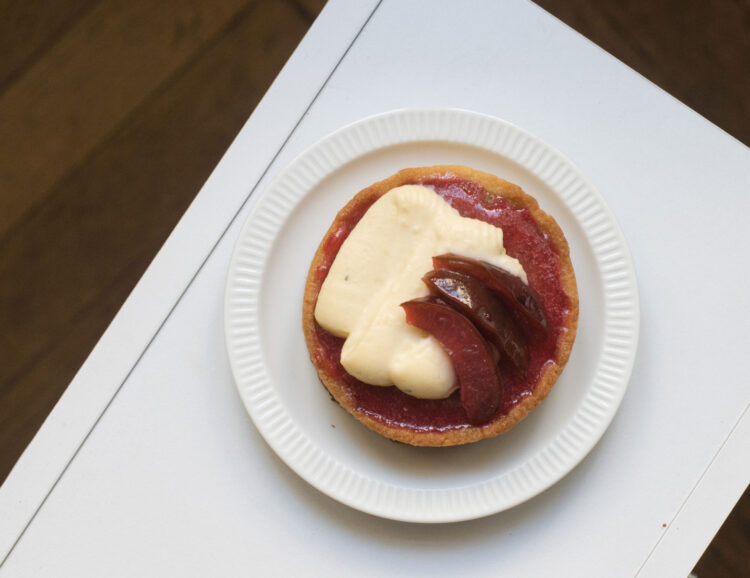




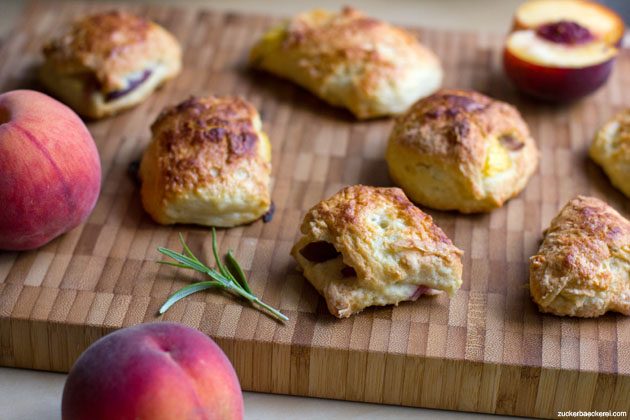

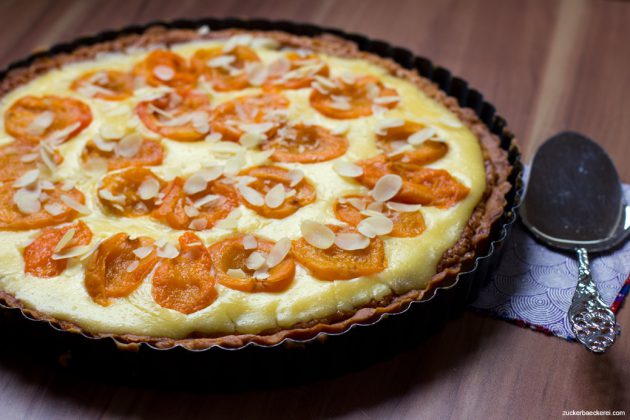
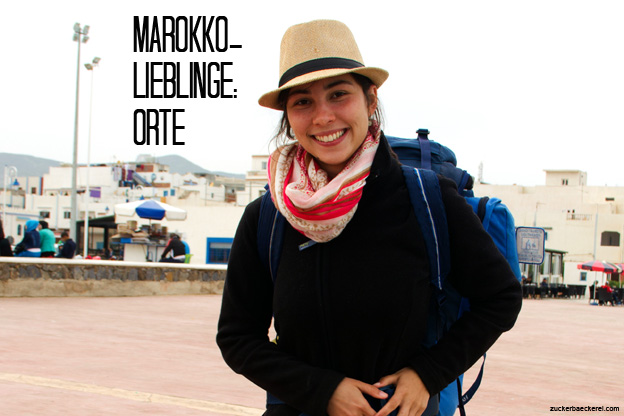
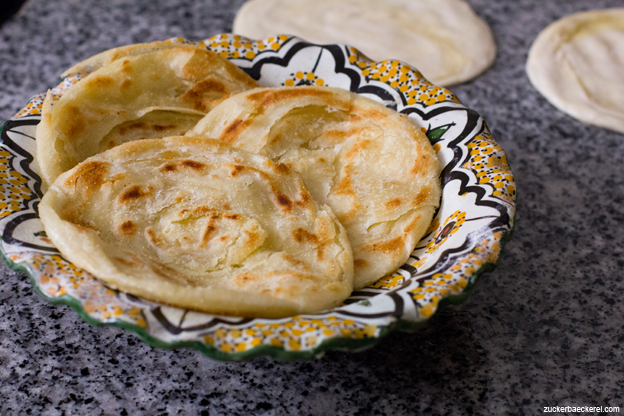
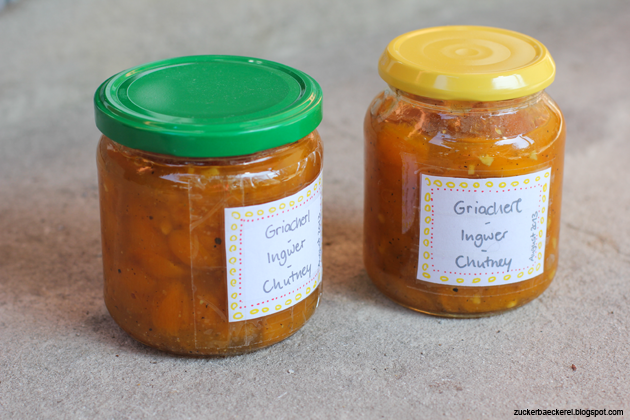

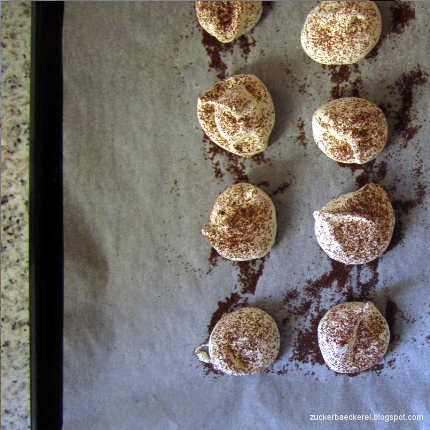

- 2023: Zwetschgen-Walnuss-Feigenblatt-Tartelette
- 2022: Brombeer-Streusel-Schnitten
- 2021: Mandel-Schoko-Cupcakes (ohne Milchprodukte!)
- 2020: Limetten-Kardamom-Cupcakes
- 2019: Stachelbeer-Frangipane-Tarte
- 2018: Pfirsich-Rosmarin-Scones
- 2017: Eine Reise in die USA, Pt. 1: NY
- 2016: Frangipane-Tarte mit Kardamomcreme und pochierten Marillen
- 2015: Marokko-Lieblinge: Orte
- 2014: Msimn – Marokkanische Pfannkuchen
- 2013: Griacherl-Ingwer-Chutney
- 2012: Windbeutel
- 2011: Kaffeebaiser
- 2010: Knusperfladenbrot

 Hi, ich bin Jana. Seit 2009 veröffentliche ich hier wöchentlich Rezepte, Reiseberichte, Restaurantempfehlungen (meistens in Wien), Linktipps und alles, was ich sonst noch spannend finde. Ich arbeite als Redakteurin bei futurezone.at, als freie Audio-/Kulinarikjournalistin und Sketchnoterin. Lies mehr über mich und die Zuckerbäckerei auf der
Hi, ich bin Jana. Seit 2009 veröffentliche ich hier wöchentlich Rezepte, Reiseberichte, Restaurantempfehlungen (meistens in Wien), Linktipps und alles, was ich sonst noch spannend finde. Ich arbeite als Redakteurin bei futurezone.at, als freie Audio-/Kulinarikjournalistin und Sketchnoterin. Lies mehr über mich und die Zuckerbäckerei auf der 

 Über den Tellerrand
Über den Tellerrand Bücher
Bücher Zuckersüß
Zuckersüß

